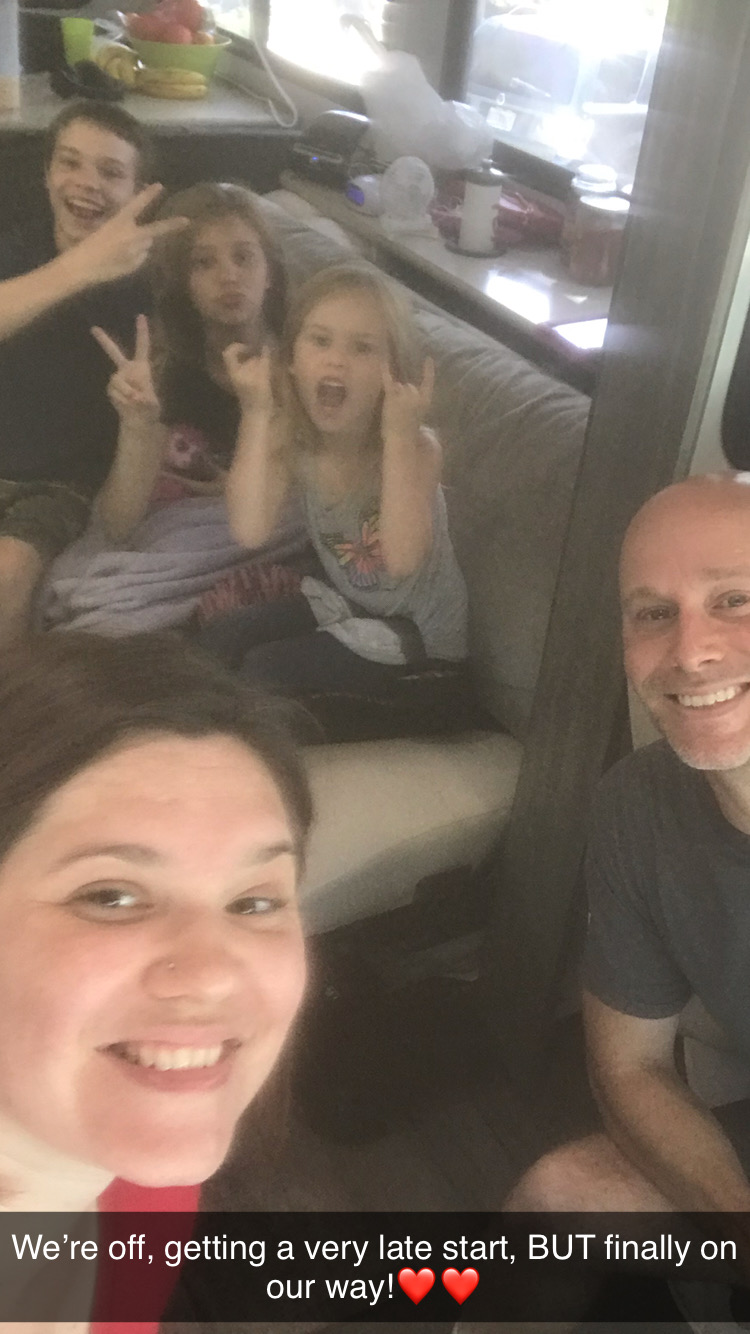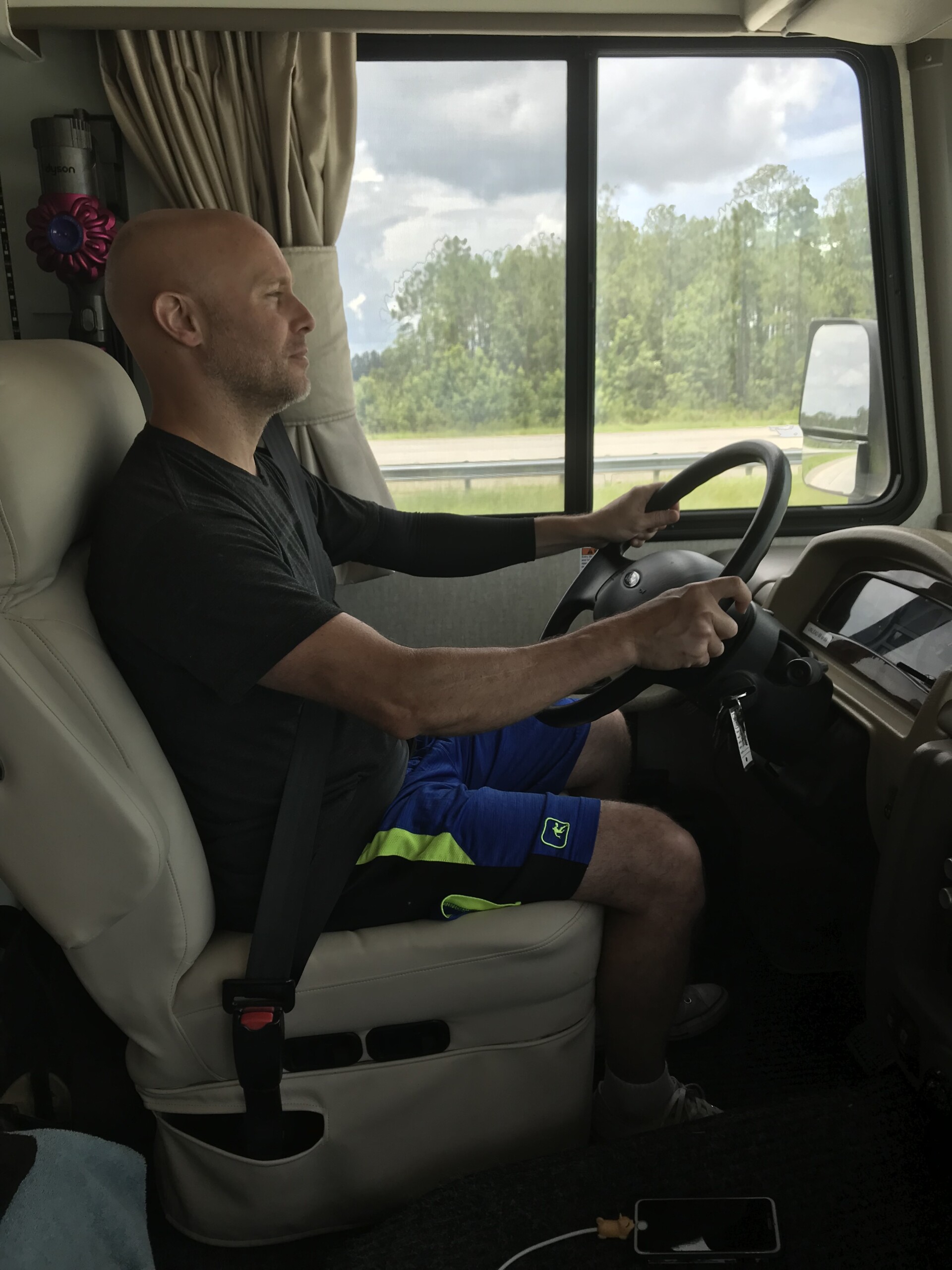Six tips to help make your RV trip go smoothly
There are several areas of consideration when we are planning an RV trip. Some of these items are: rig measurements, route, weather, how long will it take to get to the next location, pumping gas, & where will you be parking. If you are like we were five years ago, new to Rving, these things might not seem like a big deal and you may feel like you can just “wing it.” Why would this be any different from the roadtrips we’ve taken previously in a car? The truth? IT’S SO DIFFERENT! Keep reading and I’ll tell you all about it and give you tips so your RV travel trip is as worry-free as it can be.

First things first…..it was the summer of 2019 and we were traveling up the East Coast towards Maine to visit Acadia National Park. We got into the Northeast and all of a sudden I see what appears to be a very low overhanging bridge! I turned to Cliff, who was driving our motorhome, and expressed my concerns quite loudly. Luckily this bridge was clearly labeled with its height. Cliff told me that when we bought this Fleetwood Terra motorhome that one of the first things he did was measure the total height of the rig, including the ACs. He did this, without me knowing, before we had left the dealerships parking lot. This way he knew, without a doubt, if we would fit through any overhangs we came across on our drive. We didn’t want to wreck on the first drive or take out either of our two, much needed, AC units.
Tip#1: Before ever planning an RV trip, measure the complete height & length (including anything that you place on the roof of your RV while traveling, ie: racks, solar panels, SUP boards, kayaks, satellite internet, etc.) APP: There’s an app that you can download on android or iphone called CoPilot. This app allows you to put your RV measurements and weight in to keep you off roads with height and weight restrictions. We’ve used this for the past 5 years on every trip we take in our RV.
The route you take in a motorhome may not be the same one you would take in a Jeep or other vehicle. After talking with many RV travelers we’ve come to the conclusion that everyone has their own preferences with this one. In the beginning of our travel planning Cliff would always choose interstates. We could drive at safe & descent speeds, trees were not going to scrape our RV, and our weight and measurements were not a problem. We still travel this route depending on where we are going. However, now we enjoy the smaller highways and truck routes mostly. These routes take us through areas we would not be fortunate to see otherwise. There have been many amazing towns and scenic roads we would have missed altogether had we taken an interstate and unknowingly bypassed them.
Tip#2: Find what’s right for you. Interstates give you wider roads, typically, but you deal with many semi trucks driving by and blowing you around and people weaving in and out of traffic going much faster than you are able to. Smaller highways and truck routes can send you through many beautiful towns and areas that you would love, but with that comes smaller roads, and more difficult maneuvering through traffic and stoplights.
Weather is always factored into our travels. We currently drive a 2020, 38-foot ForestRiver, Georgetown GT5, aptly named “George.” When driving down the road in George we really pay attention to the weather forecast. We absolutely do not want to drive George in winds greater than about 30 MPH. You see, George, is so big and tall that he acts as a kind of sail when the wind hits. Thereby blowing him to and fro whether we like it or not. One of the scariest drives we were in was in New Mexico. The wind started to pick up, the snow started to fall, and then we saw a sign “Roadwork ahead for the next X miles.” Roadwork, in and of itself, isn’t always bad. When it comes with sidewall barriers, without any give, is where it becomes our worst nightmare. We drove, for what felt like hours, down a road without any extra wiggle room. We were terrified the whole time and kept imagining the wind or semi truck blowing us into the barriers and scraping the entire side wall of the camper and causing a wreck. That day tested us in so many ways!
TIP#3: Always pay attention to the local forecasts throughout your route when planning your RV trip. It may be sunshine and beautiful where you start from and winds and tornado watches where you’re headed. Slow down, weigh your options, and be safe. Our family always prioritizes making it from Point A to Point B safely. Sounds simple, but we’ve been in situations where we are having to drive slower, take up more room and manage to “tick off” other people on the road. While it’s not our intention to anger anyone but our safety is number one. So we humbly apologize if you were a victim of this scenario from us in the past.
How long do you drive each day on a roadtrip? For us, in our motorhome, we drive a max of 4-6 hours per travel day. When we drove our first trip up the East Coast in 2019, that time was cut in half. My husband was getting used to driving the motorhome, which was 4-5 feet shorter than George. I was too nervous, at that time, to get behind the wheel, even though we took the same driving class. I remember we set out from Tallahassee and drove to Jacksonville. It was a success! We were pumped and encouraged that we could really do this and make traveling work for us. We made it to our first destination safely, without any hiccups, and I was able to guide Cliff into our parking spot smoothly.
TIP#4: If you are new to driving a motorhome, or pulling a fifth wheel or trailer, start slow. You do not want to try driving 12 hours on day 1 and then attempting to park for the first time in the dark. We’ve seen this too many times and will let you use your imagination on what typically happens. It hardly ever ends well and is met with frustrated and disappointed travelers who want to give up before they even started.
Reminiscing about that first travel trip in 2019 reminds me of another situation we got ourselves in. As you may or may not know, it is not a good idea to try backing up with your Class A Motorhome when you are flat towing a vehicle. But this story isn’t directly about that. You see, we were somewhere in the Southeast needing fuel. We have a gas engine and finding a pump that we are able to get safely in and out of is what we are always on the look out for. This particular day we found one that looked promising. We pulled the motorhome up, filled up with fuel, and went to pull out. My job was to stand outside the RV and tell Cliff when the tires were at a particular spot so we could clear the pump and not tailswing into anything. Somehow our communication got skewed and I thought he said something different. This ended with us pulled up to the gas station, in a turn position, not able to pull forward anymore because a parked car was blocking us. We tried to disconnect our tow Jeep but were unable to because we were in a turned position. This left us blocking traffic for about 30 minutes and ultimately having to walk into the connected restaurant by the gas station and searching out the owner of the truck that was now blocking our only way out. Luckily he was gracious and willing to interrupt his lunch and move his truck for us so we could continue on our way. Phew! That was a stressful afternoon!
TIP#5: Pay attention and look for gas stations that are easy to maneuver in. If you are looking at it and think you might be able to do it but have little experience, I would continue searching until you are more comfortable and familiar with maneuvering your rig. There were times, in the beginning, that we started looking for the perfect gas station once our tank reached ½ full and it took us until ¼ or less in our tanks to find one that would work. When in doubt, take the time to disconnect your tow vehicle, if applicable, to fill up. Remember the goal is to make it from Point A to Point B safely with the rig intact. When you first start RVIng and start planning an RV trip for your first few times, we would recommend researching the gas stations ahead of time!
Finally you successfully made it to your stopping point on the way to your destination. You figured you didn’t want to pay for a campground because you’re just stopping for the night. So your plans were to boondock, but when you got here every parking lot or potential boondocking spot you could find has a sign “No Overnight Parking.” This is when planning comes into play. Whether boondocking or staying in a campground, it is always good to plan ahead. Don’t trust that the campground will have a vacancy, or that you would be able to park anywhere for the night. Plan ahead and have a contingency plan. When we plan our trips and we are planning on staying at a campground that is “first come, first serve,” we leave with enough time to get there early and always have a backup plan if the campground is full. Boondocking goes the same way. There may be plenty of boondocking locations in an area but you are in a big rig and none of those areas can accommodate your size. It’s always good to plan ahead, look at the reviews for the area, or use an app to help you. There are many websites and apps that can help in this area. Campendium is one of them. Until 2023 we had not boondocked at all. This app has been invaluable while traveling through Canada to Alaska this year. As I’m writing this we are in Anchorage, Alaska and planning in 6 days to be heading to Seward and then to Homer, Alaska. We will be boondocking at several locations and were able to plan this due to the Campendium app.
TIP#6: If you fail to plan you plan to fail. Don’t add unneeded stress to your travel day by not planning ahead. Have a plan and a backup if that one fails. Utilize multiple sources to make your trip a trip you and your group will never forget!